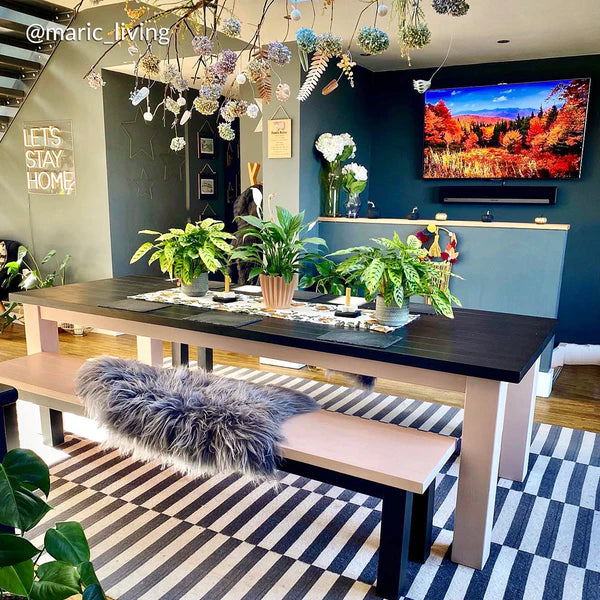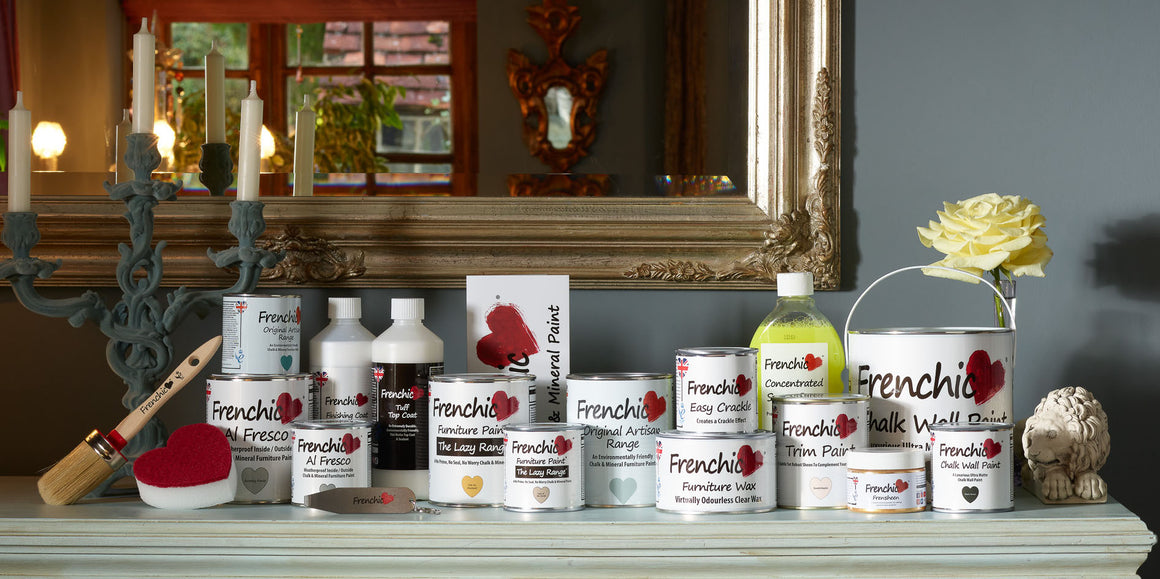Furniture Paint – Your Complete Guide
Planning on painting furniture? From choosing the right paint and supplies to prepping and painting, we’ve covered every step in this complete guide. Enjoy!
What furniture can you paint?
Where do we start? From tables, chairs, sideboards and kitchen cabinets to beds, built in wardrobes, staircases and garden sets, the world really is your oyster. Frenchic paint adheres to wood, laminate, PVC, composites and more. Just prep and paint!
Get started with this beginner’s guide to using chalk paint on furniture >

Choosing the right paint
The right furniture paint depends on what you’re painting, where it is and the effect you want to have. Self-priming and self-sealing paints, like modern chalk paint, save time and effort and also reduce the number of products you need to buy to finish the job. For even more ease of use, also look for self-levelling paint like the Lazy Range and Trim Paint, or you could choose the Al Fresco range which is also suitable for exterior use.
Alternatively, if your aim is for a decorative, or aged, look, try a traditional style chalk paint like our Original Artisan Range which allows you to get creative before sealing.
See Frenchic’s paint ranges and make the right choice >
Using primer vs. self-priming paint
Self-priming paints, like chalk paint, mean you don't have to go down the traditional approach of applying a primer before painting furniture. You can just prep and paint many types of furniture. A good choice to minimise both time and expense.
Learn more about using primer vs. self-priming paint >
Do I need to use a sealant?
Whether or not you use a sealant depends on the type of paint you’re using, as well as the conditions and wear the piece of furniture you are painting will be subjected to. For example, you can add further protection to the top of a dining table using a protective product like Tuff Top Coat, as it can increase the heat resistance of the paint.
Learn about using sealants when painting >
Choosing the right paint colours and finish
Choosing the right paint colour and finish for painting furniture can depend on a number of factors ranging from practical to personal taste. If the project is a wall full of built-in cupboards, then this will have a larger impact on the feel and style of a room than a simple side table. Think about whether you want to use a colour to blend in or stand out and also about the practicality of the finish. Furniture paint that offers a hard-wearing finish is best for ease of maintenance.
Learn about paint colours and finishes for furniture >
What supplies do you need?
Aside from your paint, we recommend using an oval brush that is specially formulated for chalk paint pickup – and can really help you achieve a smooth finish. Rollers with a paint tray are ideal for larger, flat surfaces – preferably a small roller with a low to medium pile. You’ll also need good quality fine to medium sandpaper or blocks, Sugar Soap and masking tape for most projects, plus dust sheets, something to open your tin and something to stir your paint. Read our guide for more, including supplies you’ll need for decorative effects.
Find out which painting supplies you need for your furniture project >
Best paint brushes for furniture
The best brushes for painting furniture are a personal choice, but many people find they get the best results with oval brushes with tapered bristles. Be sure to use an appropriately sized brush, with wider brushes good for larger, flat surfaces and smaller brushes useful for tight areas, corners or narrow sections.
See the best brushes for painting furniture >
How to prep your furniture
Surface preparation is important. Furniture should be properly cleaned with Sugar Soap and warm water to thoroughly degrease it and to remove other dirt – whether seen or unseen. You’ll then need to give the area a light sand to provide a ‘key’ to maximise adherence. Finally, clear off the dust and you should be ready to go. This is usually all you need to do if you are using self-priming paint like the Lazy Range, Al Fresco and Trim Paint.
Learn about furniture surface preparation for wood, metal and uPVC >
How to paint wooden furniture
For wooden furniture, a great tip is to apply the paint following the grain of the wood for a natural-looking finish. Follow instructions on the tin for coverage and time between coats. You may need more than two coats, especially if painting something dark with a light colour.
Learn more with our beginner’s guide to painting furniture >
Painting different materials
Different materials offer up their own challenges when painting. When painting rattan (wicker) type furniture, for example, you’ll want to ensure you get into all of the fine crevices with a paint brush or sprayer. Previously painted or powder-coated metal, like most radiators, can be easily painted. However, bare ferrous metals will benefit from application of a suitable primer like Zinsser 123. Being so smooth, uPVC needs to be thoroughly sanded to ensure good adhesion.
Learn about the best paint for uPVC doors and windows >
How to maintain painted furniture
When cleaning painted furniture, it's best to avoid using harsh chemicals as these can affect the paint, leaving a sticky or tacky feel to the surface. Regular use of anti-bacterial sprays may also have the same effect. Ideally, use a damp cloth and mild detergent.
Find out how to maintain painted furniture >
Painting nursery furniture
Many people worry about painting nursery furniture. The simple choice for peace of mind are products with EN71-3 certification, which is certified as safe to use on children’s toys. Paints that are water-based and low odour are also advantageous. As for colour, it’s your choice whether you go calming and neutral or bold and bright.
Read our guide on safe paints for baby cots >
Painting outdoor furniture
To paint outdoor furniture, you need paint that is weatherproof, meaning it is resistant to both water and UV rays. You’ll need to check pieces are free from algae, mould, moss, sun damage and structural issues. Areas of rot and gapping joints will need to be repaired before painting, but some items are simply too far gone.
Learn about the best paint for wooden garden furniture >
What weather conditions are OK for painting outdoors?
If you’re painting outdoors, you’ll need the weather to be warm and dry. Cold and damp conditions are problematic, but hot conditions can be too. The temperature should be between 10°C and 32°C while painting and for 48 hours afterwards. You should also avoid direct sunlight and damp or humid conditions.
Learn more about the ideal weather conditions for painting >
How do I paint porous surfaces?
If the furniture you want to paint has a porous surface, for example bare MDF or sometimes even new wood, then it is best to seal prior to painting. 2-3 coats of Finishing Coat does the trick. Or use a mist coat of paint, diluted with 5-10% of tap water. You may need to lightly sand after the first coat to get rid of the rough texture from raised grain on wood.
Read our complete guide on painting porous surfaces >
Brushing vs. rolling vs. spraying
Brushes are ideal for smaller surfaces or those with lots of contours, details and edges. Rollers are ideal for large, flat surfaces, while sprayers are suitable for any large surface or piece of furniture. However, they all leave different textures, so it is worth considering the type of finish you want.
How to choose between brushing, rolling and spraying >
How to avoid brushmarks
If you want to minimise brushmarks, choose a suitable brush and perfect your technique with a light touch. You should also apply the right amount of paint and make sure the surface is in a good condition. Choosing self-levelling paint can really help too.
Find out more in this guide to preventing brushmarks >
How to prevent and fix paint drips
Paint drips come from paint that’s too thin, applied too heavily or applied unevenly. Make sure you stir thoroughly, use dry brushes and rollers, and avoid overloading. Always keep an eye out for drips while you are painting because brushing them out as they form is the best way of removing them. To fix drips, you can sand down once dry or use a scraper for larger drips. Then touch up with paint or use filler if needed.
Learn about preventing and fixing paint drips >
How do I get a smooth finish?
The secrets to a smooth finish are painting in the right conditions, sealing surfaces before painting and using the right brushes. You’ll also need to master your technique and use the right amount of paint on your brush or roller.
Find out how to get a smooth finish when painting >
Adding decorative effects to painted furniture
There are so many effects you can add to painted furniture, from flawless matte to metallic and distressing or weathered to stencils and crackle effects. Our full guide below gives you all the inspiration and details you need.
Try these furniture paint effects >
Where to find furniture to upcycle
Take your pick from resale platforms like eBay and Gumtree, local buy and sell groups on Facebook, second-hand and charity shops, local papers and Freecycle.org.
Learn about upcycling and how to find furniture for your projects >
Ready to paint your furniture?
Frenchic makes it simple to get the best results and has all your furniture painting projects covered! Choose from self-sealing Lazy Range and Trim Paint for interior, plus the Al Fresco range which is also suitable for exterior. Or get creative with our traditional style chalk paint Original Artisan Range.
You can paint with peace of mind knowing all products are water-based with minimal VOCs with EN71-3 certification (child safe). Happy painting!
---
Title Tag: Furniture Paint – Your Complete Guide | Frenchic
Meta Description: Planning on painting furniture? From choosing the right paint and supplies to prepping and painting, we’ve covered every step in this complete guide.




























